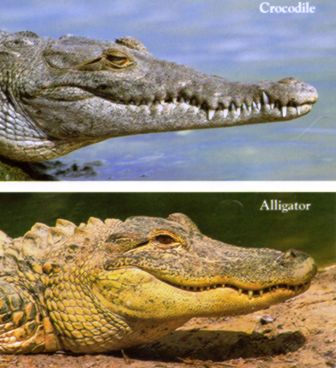Discover Florida Nature
It's time to explore the natural Florida


|
|
|
|
|
 Similar
in looks to an alligator, the American crocodile is a large reptile
found in salt and brackish waters in southern Florida Unlike
the alligator, which lives in freshwater,
Florida's native crocodile is an inhabitant of salt water shorelines.
There are far less crocodiles than alligators in Floridian nature and most of Florida's crocodile can be
found along the
mangrove bordered southern shores of
Everglades National Park. Similar
in looks to an alligator, the American crocodile is a large reptile
found in salt and brackish waters in southern Florida Unlike
the alligator, which lives in freshwater,
Florida's native crocodile is an inhabitant of salt water shorelines.
There are far less crocodiles than alligators in Floridian nature and most of Florida's crocodile can be
found along the
mangrove bordered southern shores of
Everglades National Park.
The crocodile is not as well adapted to cold weather as the alligator so South Florida is its northern limit. American crocodiles are found in southern Florida, the Caribbean, southern Mexico and along the Central American coast south to Venezuela. The crocodile is listed as endangered in the state of Florida, but recent research indicates that it is holding it's own. Crocs can swim at as much as 20 miles per hour by moving their body and tail in a sinuous fashion, but they cannot sustain this speed. South Florida is the only place in which the crocodile and the alligator occur together. Although there are reports of crocodile growing to 23 feet in South America, the record for Florida is a 15 foot male. American Crocodiles average between 7-15 feet and have an average weight of 150-450 pounds. A croc has an average lifespan of 60-70 years. Many people believe that crocodiles are more ferocious and dangerous to man than the alligator. This may be true of the infamous Nile Crocodile and other South American crocodiles, but the native Florida crocodile is much shyer than the alligator and is quick to make a hasty retreat at the approach of humans. Once hunted intensively for their hides, today, loss of habitat to human development, illegal killing and roadkill are the greatest threats faced by American Crocodiles  The
nostrils, eyes, and ears are situated on the top of the crocodile's
head, so the rest of the body can be concealed underwater for surprise
attacks. Camouflage also helps crocodiles prey on food. Full grown adult
male American crocodiles have no natural predators and are capable of
preying on virtually any animal unfortunate enough to be at the waters
edge, although even at immense sizes fish still make up the vast
majority of the crocodile's diet. The natural diet for adult crocodiles
includes water birds, small mammals, like
raccoons and
marsh rabbits, terrapins, mullet
and other fish and mollusks. Despite their custom of living around salt
water, crocodiles need to drink fresh water to keep hydrated. One way
they obtain fresh water is to sip from a thin film of rain water that
floats on top of their salty bays and estuaries. They have even been
observed snapping up raindrops as they fall. The
nostrils, eyes, and ears are situated on the top of the crocodile's
head, so the rest of the body can be concealed underwater for surprise
attacks. Camouflage also helps crocodiles prey on food. Full grown adult
male American crocodiles have no natural predators and are capable of
preying on virtually any animal unfortunate enough to be at the waters
edge, although even at immense sizes fish still make up the vast
majority of the crocodile's diet. The natural diet for adult crocodiles
includes water birds, small mammals, like
raccoons and
marsh rabbits, terrapins, mullet
and other fish and mollusks. Despite their custom of living around salt
water, crocodiles need to drink fresh water to keep hydrated. One way
they obtain fresh water is to sip from a thin film of rain water that
floats on top of their salty bays and estuaries. They have even been
observed snapping up raindrops as they fall.Mating season for the American Crocodile takes place in January and February. The female crocodile scrapes together a nest, making a mound of sand and pieces of shell, for its 30-50 eggs. The nest is only about a foot high, but is much wider than an alligators nest. It is always near a salt or brackish water shoreline. When the eggs hatch in July or early August, the female helps carry her young to the water, but, unlike the alligator, she will not continue to care for her young and fewer than half of the baby hatchlings will survive, most being eaten by hungry birds and other predators. Young juvenile crocodiles have been noted to vocalize less than other species during the first few weeks of life. It has been suggested that this lack of parental care and early juvenile dispersal is a direct result of the high hunting pressures that the species was subjected to in the second quarter of the century, causing the mother crocodile to leave her young much earlier than before, in a rapid adaptation to survive. Juveniles are a lighter color, more of a light tan, than more mature animals, with banding on the body and tail. |
|
|
Advertise | Privacy Statement | Dog Encyclopedia | Video |Contact | Alaska Nature |
|